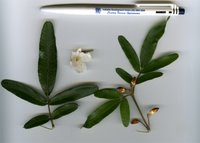 Today we had a cracker of a thunderstorm, with big chunks of hail, and a bit of rain. Robertson's summer started to feel almost normal. And, right on cue, the Eucryphia has started to flower. It always flowers from mid-February, through till the Robertson Show weekend.
Today we had a cracker of a thunderstorm, with big chunks of hail, and a bit of rain. Robertson's summer started to feel almost normal. And, right on cue, the Eucryphia has started to flower. It always flowers from mid-February, through till the Robertson Show weekend.
Eucryphia moorei, or "Pinkwood" as the early settlers knew it, is the archetypal tree of the Robertson area. Its name is used for the REPS magazine (Robertson Environment Protection Society). The Robertson Garden Club uses it for its logo, too.
This tree is found from East Gippsland (in Victoria) through to the Robertson district. We are on the northern limit of its distribution. I loves shaded gullies, in wet coastal mountainous country. No wonder it likes Robertson!
Bees love this plant. Its close cousin, Eucryphia lucida, or Leatherwood, is famous in Tasmania as a honey producing flower.
 Botanist love this plant too. There are only 4 Australian species of Eucryphia. And there are 3 species of Eucryphia in Chile! A mere 7 species - spread half-way around the globe - on either side of the vast Pacific Ocean.
Botanist love this plant too. There are only 4 Australian species of Eucryphia. And there are 3 species of Eucryphia in Chile! A mere 7 species - spread half-way around the globe - on either side of the vast Pacific Ocean.
This is plant distribution gives us a botanical demonstration of the existence of the great archaic continent of Gondwana, and the break up of that super-continent, and subsequent spreading apart of the disparate elements, owing to sea-floor movements. That is generally known as "Continental Drift". Geologists date the last time these continents were linked, in Gondwana, as being some time in the "Tertiary Period" (roughly from 65 million years ago).
 I find it fascinating that these plants have been around for such a vast period of time, and yet have diversified so little.
I find it fascinating that these plants have been around for such a vast period of time, and yet have diversified so little.
Their flower structure is so close that they are classified within the same genus. The Eucryphia family has but one genus, with just 7 species. That is a miniscule diversification over such a vast span of time. Clearly they found their suitable ecological niches, and stayed put in them. The Eucryphias have a South American/Australian connection.
By contrast, another famous Gondwanan family of plants, the Proteaceae, are vastly diversified, with about 80 genera, and literally thousands of species. They have a predominantly South African/Australian connection. While the original members of the Proteaceae family can be traced back to some 75 million years ago, it is regarded that they adapted to sudden shifts in climate in the Miocene Era (some 5 to 10 million years ago). As the Southern coninents dried out, these plants adapted, and diversified into the huge family of plants which we know today.
Both families of plants are Gondwanan in origin, though.
The local Eucryphias are just coming into flower along the top of the Jamberoo Mountain Road, as you start to run down the big hill, towards Vandenbergh Road. There are also a few just near the start of the "The Old Road", which the Council roadside clearing people famously slashed back to ground level a few years back. Fortunately, they have slowly built up again. There is a great specimen along Mackeys Lane. When driving down any of these roads, in the next few weeks, look out for a dark foliaged tree with clear white flowers, about the size of a 5 cent piece.
Eucryphia moorei is not exactly rare, but it is definitely in need of protection, for it is extremely slow growing and is slow to propagate. But, hey, if it has been around for 65 million years, it clearly has a different sense of time from us impatient human beings.
In fact, this tree, and a few other relic trees from Gondwanan times, such as the Antarctic Beech and the now famous Wollemi Pine, are the plants which are most threatened most by the prospect of catastrophic climate changes, such as Global Warming. They are all restricted to tiny pockets of remnant rainforest, dotted along the east coast of Australia.
Hot dry conditions threaten the future of the local Eucryphias, as does the careless clearing of roadside verges.
Love your local Eucryphia now, for your Great-great Grand-children might never see it.
Please bear that in mind, if you ever find yourself discussing Global Warming with the Federal Minister for the Environment, or the Prime Minister, won't you.
65 million years is such a long time to wait, just to be wiped out by 100 years of human carelessness!

No comments:
Post a Comment